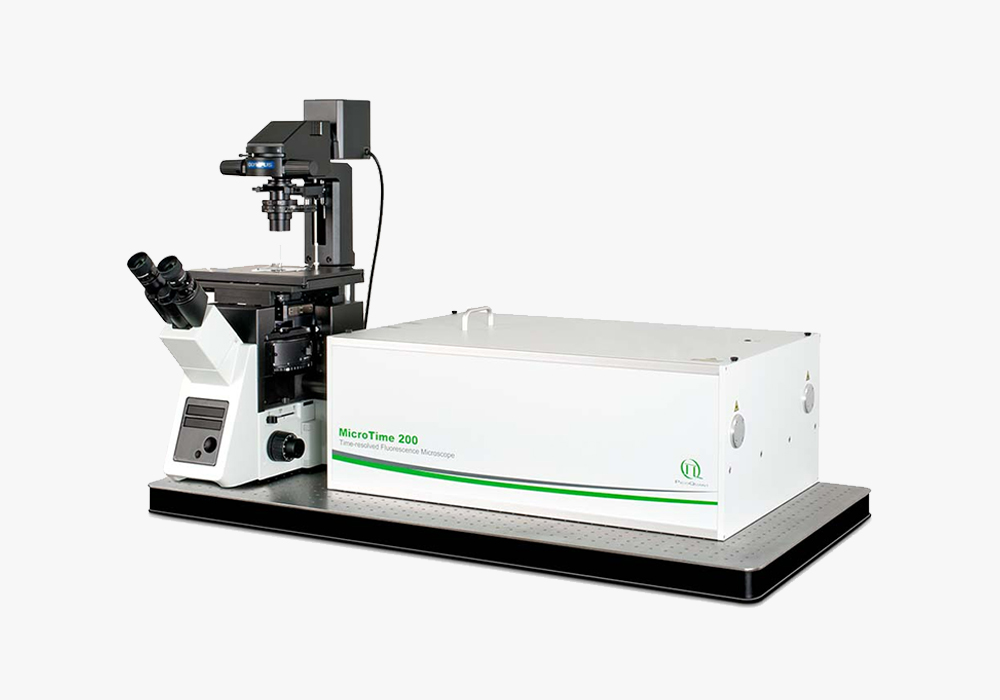TCSPC Life Time (PICOQUANT)

Fluorescence Life time Microscope
MicroTime 200
The MicroTime 200 is designed for 2-dimensional and 3-dimensional imaging experiments as well as high resolution line scans. Conventional intensity-based imaging and Fluorescence Lifetime Imaging (FLIM) is supported at a sensitivity that even permits imaging of single molecules.
Fluorescence Lifetime Imaging (FLIM) adds another dimension to conventional intensity based imaging methods.
FLIM is not affected by fluctuations in the fluorescence intensity and permits to discriminate between fluorophores with similar emission spectra (like Atto655 and Cy5) and from autofluorescence.
It can be used to probe local environmental conditions (e.g., pH value), to determine ion concentrations, to study intracellular signal transduction or to distinguish between different tissue components.
Features
- High precision 3D scanning
- Optimized light throughput
- Complementing FRET with FLIM
- FLIM with single molecule sensitivity
- FLIM images already during data acquisition
- PIE for accurate FRET measurements
- Superior positioning accuracy
Key Applications
- Single Molecule Studies
- Materials Research
- Molecular Sensing
- Interaction and Conformation Studies
- Quantitative Microscopy
- Cell Biology
- Protein Folding
Key Specifications
| Excitation system | Picosecond diode lasers (375 nm – 900 nm) with repetition rates up to 80 MHz inside a compact Laser Combining Unit | |
| Single- or multichannel laser driver | ||
| Optional : excitation down to 266 nm | ||
| Optional : external laser (e.g., Titanium:Sapphire laser) | ||
| Microscope | Inverted microscope IX 73 or IX 83 from Olympus | |
| Specially designed right side port for confocal microscopy | ||
| Left side port and back port still accessible (for e.g., widefield imaging or TIRF) | ||
| Transmission illumination unit included | ||
| Special manual sample positioning stage with 25 mm range | ||
| Standard sample holder for 20 mm x 20 mm cover slips | ||
| Optional : epifluorescence illumination, optional: cryostat for low temperature measurements | ||
| Optional : combination with Atomic Force Microscope (AFM) | ||
| Objectives | Air objectives with 20x and 40x magnification (standard) | |
| Various high-end objectives available (Oil/Water immersion, air spaced, IR/UV-enhanced, TIRF, or long working distance objectives) | ||
| Scanning | Computer controlled 2-dimensional piezo objective scanning with 80 μm x 80 μm scan range at nominal 1 nm positioning accuracy | |
| PIFOC for 3-dimensional imaging, 80 μm range at nominal 1 nm positioning accuracy | ||
| Optional : sample scanning | ||
| Optional : large area scanning table with centimeter range | ||
| Main optical unit | Confocal detection set-up in a compact housing with up to four parallel detection channels | |
| Specialized high-end major dichroics with enhanced stability | ||
| All optical elements easily accessible, adjustable and exchangeable | ||
| CCD camera for beam diagnostics and photodiode for relative power measurements | ||
| Variable beam-splitting units and exit ports to connect external devices | ||
| Detectors | Single Photon Avalanche Diodes (PDM Series, τ-SPAD) | |
| Photomultiplier Tubes (PMA Series), Hybrid-Photomultiplier Tubes (PMA Hybrid Series) | ||
| Data acquisition | Based on the method of Time-Correlated Single Photon Counting (TCSPC) in the unique Time-Tagged Time Resolved (TTTR) mode | |
| Simultaneous data acquisition of up to four detection channels | ||
| System software | Easy to use and comprehensive Windows system and analysis software | |
| 1-, 2-, and 3-dimensional data acquisition based on the versatile TTTR file format | ||
| Data archiving in workspace, time-gating for all methods, data export features, binning, TCSPC Fitting (Multi-Exponential Decay (1 to 5 Exponentials), Least-Squares Fitting, MLE Fitting, IRF Reconvolution, Tailfit, Bootstrap error analysis) |
||
| Point measurement analysis : FCS, FCCS, FLCS, PIE-FCS, FCS Fitting (models : diffusion constants, triplet state, conformational, protonation, gaussian PSF, bootstrap error analysis), FCS calibration, antibunching/coincidence correlation, total correlation, blinking (on/off histogramming), count rate histogram (PCH), intensity-gated TCSPC, fluorescence lifetime and intensity traces, lifetime histogram, BIFL (Burst Integrated Analysis) | ||
| Imaging measurement analysis : FLIM, FLIM-FRET, intensity FRET, anisotropy imaging, (time-gated) fluorescence intensity imaging, pattern matching, region-of-interest (ROI) | ||
| Scripting language (“STUPSLANG”) for user-defined analysis procedures, fitting functions, and GUI components | ||
| Scripting language (“STUPSLANG”) for user-defined analysis procedures, fitting functions, and GUI components | ||
